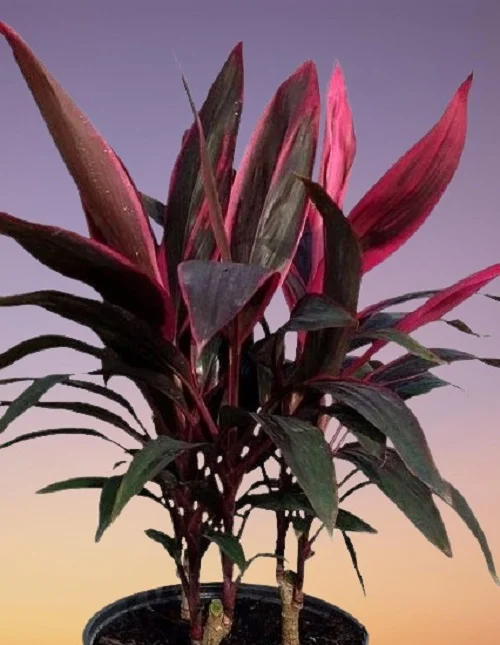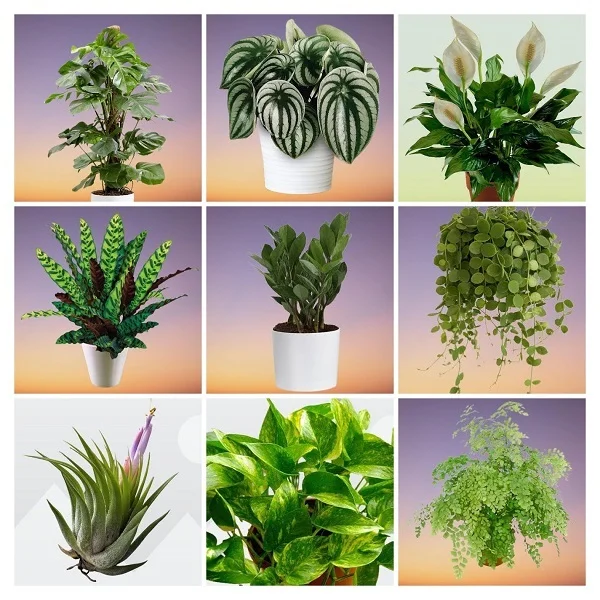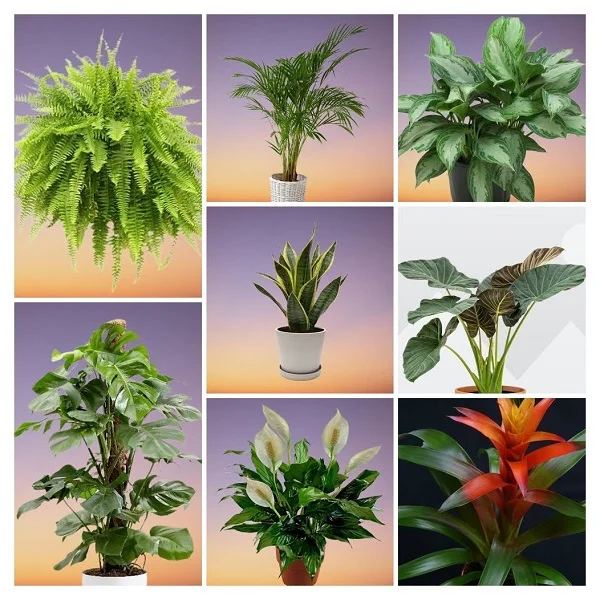Cordyline terminalis (Ti Plant) Indoor Care, Common Issues and Solutions
Some links in this post may be affiliate links
Cordyline terminalis (Ti Plant) requires bright indirect light, moderate warmth, average humidity and moderately moist, fertile, well-drained soil coupled with monthly feeding during the growing season.
Ti Plant also called Hawaiian Goodluck Plant, Hawaiian Ti Plant or Polynesian Ti is one of the popular purple-leaved plants, ideal for adding a splash of color among the greenery.
Cordyline terminalis features broad leaves usually tinged or splashed with red, pink, orange and cream. As it grows it drops the lower leaves and becomes more tree-like with a trunk topped by a crown of colorful foliage.
Hawaiian Ti Plant is a popular houseplant believed to bring good luck and hence the common name, Hawaiian Goodluck Plant.

Botanical name: Cordyline terminalis
Synonyms: Cordyline fruitcosa, Dracaena terminalis
Family: Asparagaceae
Common names: Ti Plant, Hawaiian Goodluck Plant, Hawaiian Ti Plant, Polynesian Ti
Origin
Cordyline terminalis also called Cordyline fruitcosa or Dracaena terminalis is native to the western Pacific Ocean region, from New Zealand, eastern Australia, southeastern Asia and Polynesia, with one species found in southeastern South America. It is among the popular tropical foliage plants that you can grow successfully in the home, office and other suitable spaces
Size
Ti Plant is a compact False Palm which grows to a height of about 1-2 feet and a spread of about 3-4 feet. The leaves are about 2 feet long.
Flower
In the wild Ti Plant produces pink or yellow flower-spikes but not when grown indoors.
Varieties
There are many varieties of Ti Plant. Rededge which has green leaves streaked with red is the favorite one.
Other common varieties of Hawaiian Goodluck Plant are tricolor whose leaves are green and splashed with red, pink and cream. Prince Albert whose leaves are green and red.
There are other varieties like Firebrand whose leaves are bronze. Amabilis, green and white. Baptistii, green, pink and yellow. Ti, all green and is the "grass" used for hula skirts in Hawaii. New varieties include Kiwi and Atom.
Is Cordyline terminalis toxic?
Yes. Cordyline terminalis is toxic to both humans and pets as indicated by ASPCA. The leaves contain alkyds which if ingested they may cause vomiting and excessive salivation. Keep it away from children, cats, dogs and other pets to avoid any mishaps.
Where to Buy
If you are looking to acquire these plants, healthy Ti Plants in various sizes are available online on Amazon (Link to Amazon and on Etsy (Link to Etsy).
How do you care for Cordyline terminalis indoors?
To care for Cordyline terminalis indoors, provide bright indirect light (filtered light), average warmth of 18-290C, humidity of 50-55% and moderately moist, rich, well-drained soil coupled with monthly feeding in the growing season.
Ti Plant care requires pruning to keep it neat, to discourage pests and diseases, to encourage a bushy growth, to control growth and to rejuvenate growth. Repotting is only needed when the plant is extremely pot-bound. Keep reading for more on the best growing conditions and how to provide them.

Light Requirements
Does Cordyline terminalis like sun or shade?
Cordyline terminalis grows best in bright indirect light. Do not expose it to direct sunlight as it can scorch the leaves. However, the all green varieties can tolerate some direct sunshine.
The leaves will lose color and variegation in too low light. Therefore, if the natural light is not enough, you may use a grow light to supplement it.
Can I put Ti Plant outside?
Yes. Ti Plant can be grown outdoors in USDA Hardiness Zones 10a-12b. Place it in a shaded location away from hot direct sunshine to avoid brown sunscorch leaf spots.
Watering
How often should I water my Ti Plant?
Water your Ti Plant liberally in spring and summer and allow the top 2-3 inches of soil to dry out between waterings. Maintain the soil moderately moist and avoid overwatering to prevent yellowing and rotting.
Decrease watering in fall and winter to keep the soil slightly moist as growth is slowed at this time. Do not let the soilball dry out completely to avoid wilting and drooping leaves.
Use water that is at room temperature to avoid shocking this tropical plant. In addition, make sure that the water is free of chlorine, flourides and other chemicals to prevent brown leaf tips.
Ensure that the soil is free-draining and the pot has a drainage hole to avoid waterlogging which can lead to root-rot and death of the plant.
Temperature and Humidity
Cordyline terminalis prefers an average warmth of 18-290C with a minumum of 150C. Keep it away from drafts to avoid a temperature flactuations which can result in brown leaf tips, leaf drop and reduced growth.
Ti Plant flourishes in a humidity of 50-55%. If the air is too dry, set the pot on a wet pebble tray to up humidity or grow the plant in the moist areas of the home. Maintain good air flow to minimize fungal diseases.
Fertilizer
What is the best fertilizer for Ti Plant?
The best fertilizer for Ti Plant is a balanced, water-soluble fertilizer that contains micro-nutrients as magnesium deficiency will lead to yellowing of leaves.
Feed it monthly in spring and summer. Stop feeding in fall and winter as growth is minimal and feeding at this time can cause fertilizer burn.
Regularly flush out accumulated salts from the soil by running a stream of water through the soil until the water comes out through the drainage hole.
Potting Soil
The best potting soil for Ti Plant should be rich in organic matter and free-draining to prevent it from getting soggy while providing the required nutrients.
Repotting
Repot your Ti Plant at the beginning of the growing season (spring to early summer) when roots begin to grow through the drainage holes as it prefers to be slightly root-bound.
Use a pot 1 size larger and one that has drainage holes. Refresh the top 2-3 inches of soil with fresh soil every 2-3 years for older, larger plants. Check out these ceramic pots with drainage holes on Amazon.
Pruning & Grooming
Pruning Cordyline terminalis requires removal of dead and yellow leaves to maintain the plant neat as well as reduce pest and disease infestations.
To make Ti plant bushy, sever the stem at the desired height to encourage new stems to sprout below the cut. This will result in the plant producing several stems instead of having just one stem.
When the plant becomes too tall, you may cutback the stem at the desired height to encourage new growth to sprout at a point just below the cut. The foliage emanating from the pruning, can be used to propagate new plants.
Mist the leaves occasionally and clean them by damp-wiping with a soft cloth to get rid of dust and discourage pests and diseases.
Cordyline terminalis Propagation
Cordyline terminalis (Ti Plant) is propagated by air layering, from stem cuttings or by use of the crown from old leggy canes at the beginning of the growing season when it is actively growing.
Learn how to propagate Ti Plant (Cordyline terminalis) by 3 methods.

Cordyline terminalis Problems & Remedies
Ti Plant (Cordyline terminalis) problems are plant dying, yellowing leaves, brown leaves, brown leaf tips, loss of variegation, diseases, and pests among others. Keep reading for more on these problems and how to fix them.
Ti Plant dying
Why is my Ti Plant dying?
Your Ti Plant is dying is due to root-rot, cold drafts, salts buildup, and too little light.
Root-rot: The disease is prevalent in soggy soil. It is characterized by yellowing and wilting of the leaves which is rapidly followed by browning and plant collapse.
How to fix it
- Carefully slip the plant out of its pot and inspect the roots.
- Trim brown-black, mushy roots and treat the healthy roots with a copper-based fungicidal solution as recommended by the manufacturer.
- Disinfect the pot with the fungicidal solution or use a fresh pot to repot the plant in fresh, well-draining soil.
- Do not water the plant immediately and keep it dry for 5-7 days before you can resume watering.
- Use a pot with a drainage hole and well-draining soil to prevent the soil from soggy.
- Cut down on watering in fall and winter as growth is minimal at this time; keep the soil slightly moist.
Cold drafts: Maintain an average warmth by keeping the plant away from cold drafts coming from windy doors, drafty windows, and AC units among others.
Salts buildup: Regularly flush out salts from the soil by running a stream of water through it until it drains through the drainage hole.
Too little light: Position the plant in a brighter spot where it will receive bright indirect light or use a grow light to supplement the light.
Yellowing leaves
Why are the leaves of my Ti Plant turning yellow?
Some of the causes of yellow leaves on your Ti Plant are inconsistent watering, soggy soil, drafts, too little light, nutrients deficiency, and aging.
How to fix it
Inconsistent watering: Water when the top 2-3 inches of soil feel dry. Do not water on a schedule.
Soggy soil: Use a pot that has a drainage hole and soil that is free-draining.
Drafts: Keep the plant away from drafts coming from windy doors and windows, AC units, stoves, hot air vents among other.
Too little light: Move the plant to a brighter spot or use a grow light if the natural light is not enough.
Nutrients deficiency: Feed monthy in spring and summer with a balanced, water-soluble fertilizer that contains micro-nutrients asa magnesium deficiency will cause yellowing.
Aging: This is a natural process; as the plant matures it sheds the lower leaves. Each lower leaf turns yellow and dries leaving a crown of leaves on top of the cane-like stem of the plant.
Brown leaves
Why are the leaves on my Ti Plant turning brown?
The main causes of brown leaves on your Ti Plant are incorrect watering, too little light, temperature stress, and direct sunlight.
How to fix it
Incorrect watering: Water when the top 2-3 inches feel dry but do not allow the soilball to dry out completely.
Too little light: Position the plant in a brightly-lit spot or use a grow light if the natural lighting is not adequate.
Temperature stress: Keep the plant from drafts emanating from hot surfaces, hot air vents, AC units, windy doors, drafty windows and others.
Direct sunlight: Move the plant to a more shaded spot or use a light curtain to shield it from direct sunshine.
Brown leaf tips
Brown leaf tips on Ti Plant are caused by dry air, underwatering, salts accumulation, and drafts.
How to fix it
Dry air: To elevate humidity, set the pot on a wet pebble tray or use a humidifier. You may also grow the plant in a well-lit bathroom, kitchen and other humid areas in the home
Underwatering: Water when the top 2-3 inches of soil dry but do not allow the soil to dry out completely.
Salts accumulation: Use chemical free water and regularly flush out salts from the soil by running a steady stream of water through the soil for a few minutes.
Drafts: Position the away from drafts emanating from air conditioning units, windy doors and windows, stoves, hot air vents among others.
Loss of leaf color in Variegated Ti Plant
Loss of leaf color in variegated Ti Plant is due to too little light. A variegated plant requires more brighter light than the all green varieties.
How to fix it
Position the plant infront of a large, brightly lit window where it will receive bright indirect light and shield it from direct sunlight. Alternatively, grow the plant under a grow light if the natural lighting is not sufficient.
Diseases
Ti Plant is prone to leaf spot disease which is prevalent in humid, stuffy conditions. The disease is characterized by brown, moist spots on the foliage. In a serious attack the spots can enlarge and merge, killing the whole leaf.
How to fix it
- Remove and burn the affected parts to reduce the risk of spread to the rest of the plants.
- Spray the affected plant with a systemic fungicide and ensure to follow the manufacturer's instructions.
- Keep the plant on the dry side and do not mist it for several weeks.
- Improve air circulation for the plant to discourage the disease.
Pests
Common pests of Ti Plant are mealybugs, fungus gnats, scale insects and spider mites.
How to fix it
- Check underneath the leaves regularly for these pests and take timely control measures.
- Isolate the affected plant to prevent spread to other plants.
- Treat the infested plant with neem oil or insecticidal soap as per the manufacturer's instructions.
- Regularly damp-wipe the leaves with a soft cloth to discourage the pests.
- Maintain the plant well pruned to minimize the hiding and breeding places for these pests.
You liked it? Share on social media.
Related Content
Amazon Associates Disclosure
Homeplantsguide.com is a participant in the Amazon Services LLC Associates Program, an affiliate advertising program designed to provide a means for sites to earn advertising fees by advertising and linking to amazon.com.





